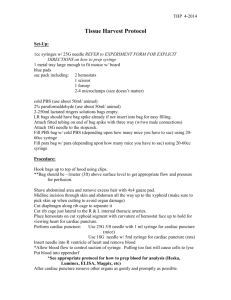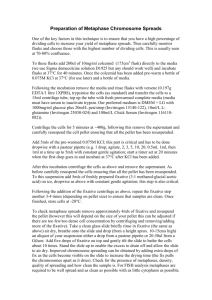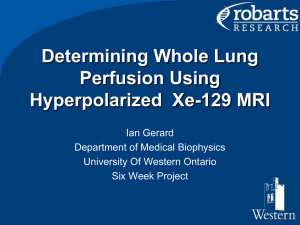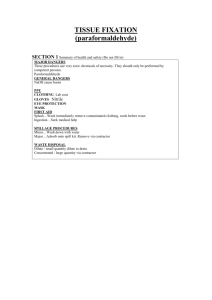Perfusion - Meyer Instruments
advertisement
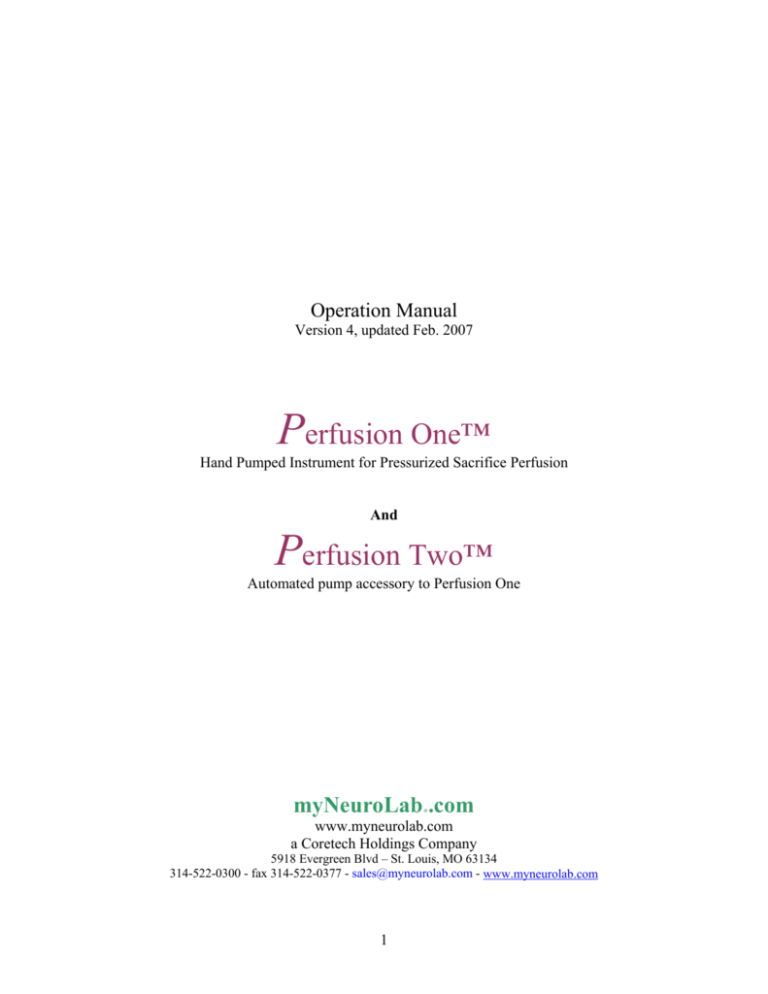
Operation Manual Version 4, updated Feb. 2007 Perfusion One™ Hand Pumped Instrument for Pressurized Sacrifice Perfusion And Perfusion Two™ Automated pump accessory to Perfusion One myNeuroLab..com www.myneurolab.com a Coretech Holdings Company 5918 Evergreen Blvd – St. Louis, MO 63134 314-522-0300 - fax 314-522-0377 - sales@myneurolab.com - www.myneurolab.com 1 Table of Contents Table of Contents ------------------------------------------------------------------------------- 2 Components of Perfusion One™ ------------------------------------------------------------- 3 Components of Perfusion Two™ ------------------------------------------------------------- 3 Notes on Usage---------------------------------------------------------------------------------- 3 Protocol for Rat --------------------------------------------------------------------------------- 5 Protocol for Mice ------------------------------------------------------------------------------- 6 Perfusion Two Setup --------------------------------------------------------------------------- 7 Protocol for Perfusion Two -------------------------------------------------------------------- 8 Rational and Background for No Shrink Fixation ------------------------------------------ 9 Care and Cleaning ------------------------------------------------------------------------------ 10 References --------------------------------------------------------------------------------------- 11 Warranty ----------------------------------------------------------------------------------------- 11 Appendix A: Draft Methods Section --------------------------------------------------------- 12 Appendix B: Common Solutions in Histology --------------------------------------------- 13 Left Brain is rat fresh tissue, unfixed Center Brain was fixed with Perfusion One Right Brain was fixed with traditional gravity perfusion 2 Components of Perfusion One The Perfusion One is a wire rack w/ four bottle lids w/3 ports each affixed at the top. The lids are clamped in position, do not unclamp them. To remove bottles, unscrew them. The wire rack will come with a cover over tubing interconnecting these ports, and a bottom tray. A pressure gauge mounted on the cover monitors pressure to the fluid. Three flexible tubes conduct fluid to a couple of “Y” connectors to join them into a single flow line w/ a connector. A connector allows attachment of a tube for mice, or a tube for rats (both included). Both have quick connect tops to attach to Perfusion One, and Luer endings to attach gavage needles (included). Mice need the one with lower internal volume, due to the much lower flow rate through a mouse. See useage notes for rationale. Tubing from the lids connects to 3 numbered ports on the side of the cover. When used in manual mode, the rubber bulb (included) connects to port one, and a jumper tube (included) connects port two and three. Alternatively, a Perfusion Two automation package, which also has 3 numbered ports, is connected with short tubes, each port to its corresponding number. A pack of 3 sizes of flexible feeding needles for transcardiac perfusion of different species, plus a 22 gauge needle for mice are included. Use the largest needle that fits the animal. Four 1 liter bottles with closed caps (2 liter bottles are available, and fit the same caps) Components of Perfusion Two Control box with electrical cord and 3 short polyethylene tubes which have quick-connect connectors at each end. Mount on top left of Perfusion one. Connect the numbered tubes. NOTES on USAGE The first bottle on the left is an air tank. Never put fluid in it. No need to ever remove it. Do not overfill the bottles, you may get fluid back up into the pressure source. Just to the start of curvature is fine. The ratio of volume in the final tube to flow rate through the animal must be kept in the appropriate range. Larger animals require a larger final tube; small animals require a small final tube. A rat tube would take a long time to empty at the flow rat through the mouse, and thus delay the switch from prewash to fixative. Never unclamp the bottle lids on the rack, just unscrew the bottles from them. Screw the filled bottles into place. The second bottle is for 10% sucrose prewash solution (isotonic at 9.25%), in distilled water. The purpose is to wash out all sodium ions. Exposure will be brief. Sucrose in distilled water gives excellent results for most purposes. Do not add buffer without adjusting solution to isotonic. Do not use significant amounts of sodium containing buffer. 3 The third bottle is for fixative. The flowing sucrose will have washed away many ions, and the intracellular compartment will no longer be “isotonic”. Formaldehyde crosses cell membranes readily, and therefore contributes only transiently to tonicity. Fixative in distilled water will cause somewhat enlarged organs, fixative in “isotonic” buffer will cause shrinkage. A middle concentration will give unshrunk organs (see Microsopy Today reference). The fourth bottle is optional for postwash, cryoprotect, or second fixative solution. In most routine procedures, the 4th bottle will not be used. It must be clamped off thoroughly or will serve as a 2nd air reservoir, doubling the time to pump up pressure. There is a clamp mounted on the inside top that must be tightly closed. If the fourth bottle is to be used (filled with fluid) this clamp must be opened or removed when the bottle is off. If there is pressure leakage, check this clamp inside the bottle. Always fully de-air the lines prior to use. Air bubbles will block off flow through the blood vessels and leave tissue unfixed. Do this by holding the end of the tube up high, and slightly pressurizing the bottles. Unclamp the right most bottle with fluid in it. When the fluid is flowing without air in the line up to the Y, clamp the line and unclamp the next bottle to the left, repeat, ending with the sucrose bottle. Flow enough sucrose to chase the fixative out of the lines, and all air bubbles. Do not worry about the slight diffusion of fixative into sucrose as the fluids contact at the Y connector. Its effect is negligible. Permanently mark one bottle for use with sucrose, another for fixative, and do not switch. Obtain extra bottles if you do several perfusions in a day, or refill the bottle you are using. When preparing animals for perfusion, haste is of the essence, cut rapidly and big bites, but do not cut off the breastbone, the subclavian artery runs along it. Pull the breastbone up and clamp it with forceps. The heart must be fully exposed to work freely. Larger (2 liter) bottles are available for larger animals. The animal’s vascular resistance should be determining the overall flow rate for the Perfusion One to work. To determine if the tubing or needles of the Perfusion One are determining the flow rate, try expelling a fluid through the complete setup, minus the animal, and time it. It should run out much faster without the animal. If it does not, you need to obtain a larger needle and/or larger lumen tubing for the animal you are perfusing. For questions about histology not directly related to this perfusion instrument, subscribe to the histonet listserv. Go to http://lists.utsouthwestern.edu/mailman/listinfo/histonet and subscribe. You will begin receiving emails with histology question, and answers from experts. After subscribing, send an email to the same address with an appropriate subject line and message. Everybody on the list (mostly lifetime histology experts) will get a copy of your question. Most will delete it. Those that know the answer will respond with expert information. When you have your answer, if you wish to stop the flow of email, unsubscribe. 4 Perfusion One™ Protocol for Rats 1) Prepare 10% sucrose solution (100 grams sucrose in 1 liter of distilled water). 2) Suggestion: Chill overnight after sucrose is dissolved. Cold will not affect the rate of blood washout, but should slow the very rapid autolysis that begins with onset of anoxia. 3) Prepare your fixative solution in distilled water to avoid shrinkage. If buffer is used, make it much less than isotonic to minimize shrinkage. Commonly, 4% paraformaldehyde, 1% glutaraldehyde solution made up fresh. Preferably warm, temperature may affect the rate of fixation. 4) Have sturdy skin scissors, a cats-claw tweezers and a pair of locking mosquito forceps. 5) Screw bottles into place on tubing system (you may also use 2 liter bottles). a. Bottle 1 is the air reservoir. Pressure is pumped into this bottle. b. Bottle 2 is for 10% sucrose c. Bottle 3 is for fixative solution d. Bottle 4 is optional, usually not used or for postfix cryoprotection solution. 6) Be sure the larger rat final line and midsize needle are installed. 7) Secure the needle against movement. Pump the rubber bulb once, and operate the tubing clamps so as to flow fixative, then sucrose to just clear all air from the tubes. Flow enough sucrose to clear fixative from the final tube. Be careful not to spray at people or in eyes. Relock the clamps. 8) Inject rat with an overdose of an injectable anesthetic (e.g. sodium pentobarbital, 120 mg/kg) IP (intra peritoneal). Wait for full anesthesia (no response to hard pinch) 9) Lay the animal over grid (stainless lid from a plastic cage, or a barbecue grill from your local hardware store). 10) Cut the entire ventral surface of skin over abdomen and pull up thorax to expose the heart. Clamp the thorax up out of the way. Do not be timid. Perfusion must start as soon as possible after entering the chest. 11) Grab the lower part of the heart with the tweezers, and cut it off (about half). 12) Open the hand clamp to allow sucrose to flow (do not add pressure yet). 13) Working briskly, insert the feeding needle at the end of the perfusion line (while oozing sucrose at low pressure) well up into the ascending aorta, pass through the open lower heart. Clip the locking forceps around the aorta behind the bulb on the needle to secure the needle in place. Note: The needle is flexible, and may be curved into any desired bend up to 45 degrees without crimping. 14) Quickly pump the pressure up to 300 mm/hg. Most blood will be cleared before you get there. Let it run until shortly after the animal stops moving. This indicates that the extracellular fluid has been sufficiently replaced. 15) Release the fixative flow, let both run for a minute, then clamp the sucrose flow. Let it run nearly out. Formaldehyde takes from 4-24 hours to fully fix. If possible, do not dissect out the brain until at least 4 hours after perfusion (Cammermeyer, 1960) 16) If a postfix cryoprotectant is perfused ( i.e. 30% sucrose), it should contain low concentation fixative as well, and PBS. 5 Perfusion One™ Protocol for Mice 1) Prepare 10% sucrose solution (100 grams sucrose in 1 liter of distilled water, a liter will be enough for several mice). Suggestion: Chill overnight after sucrose is dissolved. Cold will not affect the rate of blood washout, but will slow rapid autolysis that begins with onset of anoxia. 2) Prepare your favorite fixative solution; filter (#2 Whatman) into 1 liter bottle. Try 4% paraformaldehyde, 1% glutaraldehyde distilled water solution made up fresh. Preferably warm, temperature may affect the rate of fixation. 3) Have sturdy skin scissors, a cats-claw tweezers and a pair of locking mosquito forceps handy. 4) Screw bottles into place on tubing system (you may also use 2 liter bottles). a. Bottle 1 is the air reservoir, with the pump bulb and gauge attached b. Bottle 2 is for 10% sucrose c. Bottle 3 is for fixative solution d. Bottle 4 is optional, usually not used or for postfix cryoprotection solution. 5) Install the smaller mouse final line, and the smallest (22 ga) needle 6) Secure the needle against movement. Pump the rubber bulb once, and operate the tubing clamps so as to flow fixative, then sucrose to just clear all air from the tubes. Flow enough sucrose to clear fixative from the final tube. Be careful not to spray at people or in eyes. Relock the clamps. 7) Inject mouse with an overdose of an injectable anesthetic (e.g. sodium pentobarbital, 120 mg/kg) IP (intra peritoneal). Wait for full anesthesia (no response to hard pinch) 8) Lay the animal on a grid (stainless lid from a plastic cage, or a barbecue grill from your local hardware store). Put it over a collection container. 9) Cut the entire ventral surface of skin over abdomen and pull up thorax to expose the heart. Clamp the thorax up out of the way. Do not be timid. Perfusion must start as soon as possible after entering the chest. 10) Grab the lower part of the heart with the tweezers, and cut a small hole in it. 11) Open the hand clamp to allow sucrose to flow (One hand pump of pressure). 12) Working briskly, insert the feeding needle at the end of the perfusion line (while oozing sucrose at low pressure) into the heart. Do not attempt to enter up to the aorta, it risks puncture. Hold the needle in place. Cut a major vein back to the heart to allow drainage. 13) Quickly pump the pressure up to 300 mm/hg. Most blood will be cleared before you get there. Let it run until shortly after the animal stops moving. This indicates that the extracellular fluid has been sufficiently replaced. 14) Release the fixative flow, let both run for a minute, then clamp the sucrose flow. Formaldehyde takes from 4-24 hours to fully fix. If possible, do not dissect out the brain until at least 4 hours after perfusion (Cammermeyer, 1960) 15) If a postfix cryoprotectant is perfused ( i.e. 30% sucrose), it should contain low concentration fixative as well, and PBS. 6 Perfusion Two ™ Setup Congratulations on your new Perfusion Two automated perfusion system! This sub-manual describes the Perfusion Two automation package to be added to a Perfusion One apparatus. If you have an existing Perfusion One made before 2007, and it does not have the left side tubing connectors, call MyNeurolab for arrangements to modify your unit to be used either manually or automatically. The Perfusion Two will help to maintain consistency in animal sacrifice perfusion/fixation procedures, and requires less hand involvement at critical times (the pressure is automatically pumped up), than the Perfusion One alone. The automation package will come with the chassis, 3 plastic tubes with a connector on each end, a power mains cord, and this manual, which is also posted on our website at www.myneurolab.com The chassis sits on top of a Perfusion One apparatus, on the left side. Connect the 3 tubes between the corresponding numbers on the Perfusion One and Two. (see left side of Perfusion One). Connect the power cord between the chassis and a power mains. Follow the protocol below to operate the instrument. See Appendix A for common solution recipes. Whenever the power switch is on, an automated air compressor pump maintains a constant 300 mm Hg pressure in the air tank bottle. The pressurized air tank is only connected to the fluid bottles when the rotary AIR TANK switch is in the CONNECT position. In the DISCONNECT position, the compressor maintains 300 mm Hg pressure in the air tank, but this is not applied to the fluid bottles. The PERFUSION PRESSURE switch enables holding or releasing to air the pressure in the fluid bottles. A small pressure can be let through and held to be used to remove bubbles from the system and to have a slow flow as the needle is inserted. To achieve this, pressurize the system briefly by flicking the AIR TANK switch to CONNECT, then back to DISCONNECT while the PERFUSION PRESSURE switch is in HOLD. Switch it briefly to RELEASE, watch as the pressure drops, and when it gets to the desired pressure, rotate the PERFUSION PRESSURE rotary switch to HOLD. The pressure will stop escaping from the fluid bottles. You can add pressure at any time by switching the AIR TANK switch to CONNECT. 7 Perfusion Two ™ Protocol Preparatory Steps 1) 2) 3) 4) 5) 6) 7) 8) 9) 10) 11) Rotate both rotary switches to the left. Secure the white clamps on the fluid lines of the Perfusion One, all tightly closed. Turn on power switch on back. Fill the two middle bottles on the Perfusion One with pre-made solutions. Prewash to the left. Inject the animal with anesthetic, but do not cut yet. Rotate AIR TANK switch to CONNECT position (to right). Flick PERFUSION PRESSURE switch to the RELEASE and back to HOLD. The reading on the pressure gauge should then show about 50 mm Hg. Pressure can only enter when in the RELEASE position. Rotate AIR TANK switch back to DISCONNECT (left). Flick PERFUSION PRESSSURE switch to RELEASE (right) until the pressure is about 25 mm Hg on gauge. Flick back to HOLD (left). Clear air from the lines. Unclamp and flow first fixative as far as the final junction, then prewash solution, holding the needle end high to de-air the lines, and to wash the fixative out of the lines so prewash fluid will flow first when the animal is perfused. Be careful not to direct flow at a person or in eyes. Install the appropriate needle on end of Luer connector. Time Critical Steps 12) 13) 14) 15) 16) 17) 18) 19) 20) 21) 22) 23) 24) Cut into the animal as quickly as possible after diaphragm is punctured to expose the heart fully. Knick into the bottom of the left ventricle (your right) with a scalpel. Release the white clamp on the Prewash tubing to start low pressure flow. Quickly insert the needle into the heart through the knick. For a rat, clamp the aorta with the needle in it, for a Mouse hold the needle in the lower heart. Rotate AIR TANK to CONNECT (right) and PERFUSION PRESSURE switch to RELEASE to begin pressure perfusion. Watch the animal. When movement stops, wait about 5 seconds. Unclamp the fixative line, then quickly reclose it to the first snap, so fixative will leak into the prewash solution slowly. Wait about 20 seconds (use timer if helpful) for fixative to pass through the tubes and enter the animal. No twitch should be seen if sucrose has penetrated. Completely release the Fixative clamp. Clamp the Prewash line tightly. Rotate the AIR TANK switch to DISCONNECT (left). Rotate the PERFUSION PRESSURE switch to the HOLD position after the pressure declines to about 125 mm Hg. Turn on the timer, wait the desired time period. See the Perfusion One Manual for thoughts on this period. 8 Notes: The Air Tank Bottle is pumped up and held just above 300 mm Hg as soon as the power is turned on. The gauge measures the pressure in the fluid containing bottles, which is controlled by the rotary switches. Steps 5-7 set a low pressure in the fluid lines to de-air and to start flow in the animal. On step 16, an aperture in the air pressure path will slow the rate of pressure rise in the fluid bottles. This lets the blood be washed out before the blood brain barrier breaches. Steps 18-19 allow fixative and prewash to mix, so that fixative is more dilute on first exposure than it is later in the procedures. This is recommended by Cragg and by MyNeuroLab. Contact us by email or phone if you have any questions or useful additions to the protocol. Rationale and Background Sacrifice perfusion takes advantage of the open vascular channel to get fixative to every cell in the body as rapidly as possible. If an organ is removed and dropped in fixative, it will take as much as 24 hours for fixative to penetrate to the center of the organ, and autolysis will be ongoing in each sector until fixative arrives. Various decay artifacts will show under the microscope (Garman, 1990) in immersion fixed tissue. A further advantage of perfusion is removal of blood cells. Red blood cells catalyze HRP reactions, and autofluoresce, creating background staining for two of the most common cell labeling methods. However, perfusion fixation by the traditional method ( 0.9% saline (isotonic) prewash followed by fixative) results in about a 20% shrinkage of the gross structure of the brain and other soft tissue. Internal anatomy is distorted from the positions in the living brain. Electron microscopy shows cells tightly abutted against one another, with little or no extracellular space, although resistance studies and other means show that the brain is about 20% extracellular space in the living animal. This is because when fixative arrives at the outside of the living cells, the first thing inactivated by it is the sodium pump proteins on the outside of the cell membrane. Hence, sodium ions rush in. Water also rushes in to balance osmolarity. The cells swell. Formaldehyde-based fixative cross links proteins in the (now) adjoining cell membranes. When complete fixation and ion equilibrium is eventually restored, the cells lose the extra water and return to normal size. They pull the whole organ structure in with them, because membranes are cross-linked between cells, and arrive at normal cell size but with no extracellular space. The entire organ is shrunken and distorted in shape. Cragg, 1980, reasoned that this shrinkage could be prevented, and cells fixed in their positions in the living organ, with the natural extracellular space, if there were no sodium or other ions in the extracellular fluid when the fixative arrived. Sucrose is a non-ionizing molecule that will not enter the cell. Sucrose at 9.25% solution in distilled water is isotonic. Replacing the extracellular fluid, particularly the sodium ions, with isotonic sucrose before fixative arrives would let the cells be fixed in place, without first swelling or shrinking. 9 An obstacle to this approach is that sucrose, as with any molecule that will not cross the cell membrane, will not cross the blood brain barrier. Sucrose perfusion by traditional methods can wash out the blood, but not the extracellular fluid. This obstacle is overcome by breaking the blood brain barrier with high pressure, 300 mm Hg, during the sucrose perfusion. Do not start the perfusion at this high pressure, blood would get into the extracellular fluid. Instead, raise the pressure over about 5 seconds during the sucrose flow. The animal’s limbs will slowly move as sucrose replaces the extracellular fluid for a while, and then stop. Shortly after that, release the clamp on the fixative, then clamp off the sucrose flow, leaving only the fixative. Let flow for a while to get full penetration of the fixative, and then reduce the pressure. Flow for a while, or run the whole bottle through, it is probably not very important. It is to refresh the used fixative. More important is time of exposure to fixative. Perfusion starts the fixation evenly throughout the brain, but it does not speed up the chemical reactions of formaldehyde, which occur rapidly at first, then slowly to asymptote at about 50 hours (Helander, 1999). A coagulant fixative like alcohol fixes as quickly as it penetrates the tissue, but alcohol alone is a poor fixative (except for smears of cells or unfixed sections on slides). Tissue for histochemistry with HRP, or IHC, should not be exposed to strong aldehyde concentrations for that long, they can be over-fixed which will diminish stain intensity. If for routine Nissl or most other stains not depending on protein integrity, tissue may be stored indefinitely in formaldehyde. For any purpose, at least 4 hours exposure is necessary. If possible, the brain should be left in situ, in the skull, for 4 hours after perfusion with fixative before removal (Cammermeyer, 1960). If not, it can be removed and stored in fixative. An attractive possibility with the Perfusion One is to post wash with 30% sucrose (300 grams per liter) in PBS for cryoprotection after fixation. However, from the above, it would be wrong to wash out the fixative short of 4 hours. Post wash could wait 4 or more hours, with the perfusion needle left in the animal, or the postwash solution could contain about 2% formaldehyde to continue fixation, as well as PBS solution, .1 M, to buffer the pH. Care and Cleaning Rinse all components in distilled water after a days use. Pump distilled water from the sucrose bottle through the needle. Do not let solutions dry in or on the plastic components, and do not leave solutions in the bottles for the next day. Contact us If you have a question, a solution, or a new procedure, we would like to hear about it, and possibly to include it in this manual. Find current contact information at our web site at www.myneurolab.com 10 References Cammermeyer, "Post mortem origin and mechanism of neuronal hyperchromatosis and nuclear pyknosis." Exp. Neurol. 2:379-405, 1960 Cragg, Brian. Preservation of the Extracellular Space during Fixation of the Brain For Electron Microscopy. Tissue and Cell 12: 63-72, 1980 Garman RH, Artifacts in routinely immersion fixed nervous tissue. Toxicol Pathol 1990;18(1 Pt 2):14953 Helander, KG, ] Formaldehyde Binding in Brain and Kidney: A Kinetic Study of Fixation. J. Histotechnol. 22:317‐318, 1999. Scouten, CW, O’Connor, R, Cunningham, M. Perfusion Fixation of Research Animals. Microscopy Today 14: 26‐33, 2006 http://themerckindex.cambridgesoft.com/TheMerckIndex/AdditionalTables/pdfs/IsotonicSolutions.pdf MyNeuroLab Limited Warranty MyNeuroLab warrants this instrument to be free from defects in material and workmanship for a period of one year from the date of original purchase. This warranty covers parts and labor. We may repair or replace defective instruments at our option. There is no warranty on consumables supplied with the instrument. The warranty does not cover damage from abuse, neglect or use for purposes other than those intended and described in the manual. MYNEUROLAB/CORETECH HOLDINGS DISCLAIMS ALL RESPONSIBILITY FOR CONSEQUENTIAL DAMAGES OR INCIDENTAL LOSSES CAUSED BY USE OF THIS INSTRUMENT, except where such disclaimer is not allowed by law. To claim, visit our website at URL http://www.myneurolab.com and find the latest contact information, or call 314 522 0300. Do not ship the instrument back without first contacting the company and obtaining a routing number. This warranty gives you specific legal rights, which may vary from state to state or province to province. 11 Appendix A: Suggested Methods Section for your Publication. A methods section which may be cut and pasted from our website and edited into your journal article as needed for use in your paper is offered below. Rights are hereby granted for use of this text. Animals Sacrifice and Perfusion. Animals were administered 120 mg/kg of sodium pentobarbital by IP injection. When unresponsive to hard paw pinch, they were perfused transcardially with the Perfusion One (or Two) (www.myneurolab.com) apparatus. A prewash of 10% sucrose in water at 300 mm Hg was followed by fixative (4 % depolymerized paraformaldehyde, 1% glutaraldehyde in distilled water). Brains remained in-situ for 4 hours, and were then dissected out and stored in 10% formalin in phosphate buffered saline (PBS) until sectioning. Alternative last sentence if you will freeze the tissue: Brain remained in-situ for 4 hours. A postfixative wash of 30% sucrose with 2% formaldehyde freshly depolymerized from paraformaldehyde and in PBS was perfused for 2 minutes. Brains were then dissected out and stored in the same solution until sectioning. 12 Appendix B: Solutions used in Histology Sucrose Solution, 9.25%, isotonic, for Prewash (10% is also OK). Sucrose, 92.5 grams DH20, 1 liter Sucrose/formaldehyde Solution, 30% Post fix for cryoprotection and storage. Sucrose, 300 grams Formaldehyde from Paraformaldehye, 40 ml PBS, 0.1M 960 ml Stock phosphate buffer 0.1 M pH 6.8 49 mL 0.2 M sodium phosphate dibasic anhydrous (28.4 g Na2H2PO4 in 1 liter DH2O) 51 mL 0.2 M sodium phosphate monobasic monohydrate (27.8 g NaH2PO4-H2O in 1 liter DH2O) 100 mL distilled water NOTE: Do not use this in the prewash or fixative solution. Good for postwash and storage solutions Formaldehyde from paraformaldehdye, 4%. **Caution: Preparation should be done in a chemical hood.** In a 2000 ml Erlenmeyer Flask, add: Reagent grade paraformaldehyde powder, 40 grams Distilled/deionized water to make one liter. Add a stirring bar. Heat the liquid to 70ºC while stirring. Add 1 drop of 10M KOH. The solution should become clear after the addition of the base. Allow the solution to cool to room temperature. Adjust the pH to 7.3. Use the fixative at room temperature or better, 37ºC. Make up fresh prior to use. Do not store. Formaldehyde from paraformaldehdye, 4%, in 0.1 M phosphate buffer. 4% PFA (in 0.1M PB, phosphate buffer): 8g PFA dissolved in 100ml of dH2O. Heat to water (on heated stirrer and stir using magnetic bead) to 55‐60C to partially dissolve PFA then add 1M NaOH dropwise (one or two drops) until solution clears. Add 100ml of 0.2M PB, mix. Filter. Store at 4C. Prolonged storage (>1 week) may require that pH is checked. pH should be around 7.4. 13

